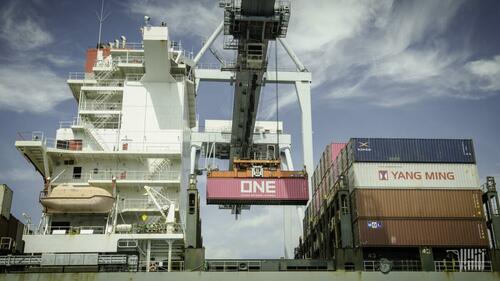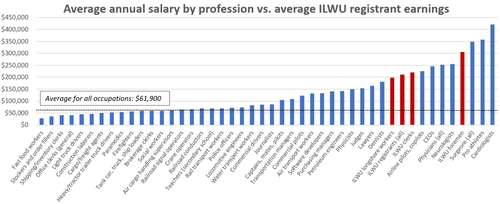
By Greg Miller of FreightWaves
West Coast container port operations are being disrupted by a dispute over the size of dockworkers’ next pay raise, with disruptions now starting to affect ship operations.
“We got a rash of vessel movements canceled overnight,” said Kip Louttit, executive director of the Marine Exchange of Southern California, on Wednesday.
Departures of six ships berthed in Los Angeles or Long Beach have been delayed: the Cosco Portugal, Cosco Oceania, Cosco Shipping Rose, CMA CGM Amerigo Vespucci, CSCL Yellow Sea and YM Unicorn. Arrivals of four ships to the ports are delayed: the Aitolikos, Cosco Denmark, Cosco Netherlands and Cosco Taicang. Yet another ship, the MSC Jeongmin, had its arrival in Los Angeles delayed Tuesday.
International Longshore and Warehouse Union (ILWU) dockworkers handle cargo across the West Coast, including at the major container gateways of Los Angeles, Long Beach and Oakland in California, and Seattle and Tacoma in Washington.
Union pushes for higher wages
The ILWU is demanding wages and benefits in the next five-year contract that reflect dockworkers’ role in the COVID-era import boom, a one-off event that ended last year. The prior contract expired July 1, 2022.
The union cited the decrease in member wages and benefits as a share of the revenues of terminal employers and ocean carriers represented by the Pacific Maritime Association (PMA).
ILWU Local 13 said that “ocean carriers and terminal operators have thumbed their noses at the work force’s basic requests” after effectively treating dockworkers’ lives as “expendable in the name of profit” during the pandemic.
If the narrative is “greedy employers take advantage of American workers,” it’s only fair to take a closer look at what West Coast dockworkers currently earn — the starting point for pay and benefits they’re seeking to boost in the new contract.
Detailed compensation data is published annually by the PMA. It shows that West Coast dockworkers are already some of the highest-paid workers in the country.
ILWU wages vs. other professions
Full-time registered longshore workers earned an average of $197,514 in 2022, not including benefits, according to the PMA. Clerks earned an average of $220,042 and foremen and walking bosses averaged $306,291. (Full time is defined as working 2,000 hours or more per year, or 38.4 hours per week.)
The PMA also paid $100,534 per ILWU registrant in benefits costs. Benefits include full insurance coverage, a 401(k) and a pension with a maximum yearly retirement benefit of $95,460.
The U.S. Bureau of Labor Statistics compiles data on average annual wages by profession. West Coast dockworkers rank toward the top when compared to the government stats.
Full-time dock foremen earned 24% more than the average CEO’s base salary in 2022 and 20% more than neurologists. ILWU clerks earned just $5,600 per year less than airline pilots. Full-time dockworkers came in 21% higher than lawyers and 9% above dentists.
Average earnings in 2022 for all full-time ILWU registrants — $211,000 — were 3.4 times higher than the average wage for all professions calculated by the Bureau of Labor Statistics.
The caveat on the PMA data is that a portion of union registrants are under the full-time threshold. Of longshore workers, 42% worked less than 2,000 hours in 2022. The bulk of longshore workers (including non-full-time workers) earned in the $100,000-$200,000 range.
Among clerks, 19% worked less than 2,000 hours, with overall earnings bunched in the $150,000-$225,000 range. Of walking bosses and foremen, only 10% did not meet the full-time definition. Salaries were grouped in the $250,000-$325,000 range. Some foremen earned over $400,000 and a few topped a half-million.
How ILWU earnings are calculated
The average 2022 ILWU registrant base rate — $46.23 per hour — doesn’t sound that steep for skilled labor. But as the PMA explained in its annual report, worker earnings also include an additional component based on skill level. Skill bonuses range from $2.40 to $5.80 per hour and were added in 80.7% of hours paid last year.
Pay also increases for the second shift (eight hours starting at 6 p.m.) and third shift (five hours starting at 2:30 a.m.) to $61 to $83 per hour. Work on these shifts accounted for 38.5% of total hours paid last year.
Then there is overtime, which accounted for 36.4% of hours paid in 2022. Overtime pay rates range from $69 to $93 per hour. Altogether, the PMA said the effects of skills bonuses, work shifts and overtime brought the effective average rate for all hours paid to $64.10.
COVID was yet another key factor. The ILWU labor force was essential to keeping goods flowing during the pandemic, despite risks to the dockworkers’ health. At least 43 union members died of COVID, according to the ILWU.
The change in consumer behavior during the pandemic led to a flood of cargo into West Coast ports that continued through the first half of last year, hiking both straight hours (non-overtime) and overtime.
The PMA paid ILWU registrants at all U.S. West Coast ports total wages of $2.31 billion in 2022, up $371 million or 19% versus 2019, pre-pandemic. The effective hourly rate rose 7% over the three-year period. Straight time was 22,895,230 hours in 2022, up 8% from 2019. Overtime came in at 13,084,540 hours, up 16%.
By Greg Miller of FreightWaves
West Coast container port operations are being disrupted by a dispute over the size of dockworkers’ next pay raise, with disruptions now starting to affect ship operations.
“We got a rash of vessel movements canceled overnight,” said Kip Louttit, executive director of the Marine Exchange of Southern California, on Wednesday.
Departures of six ships berthed in Los Angeles or Long Beach have been delayed: the Cosco Portugal, Cosco Oceania, Cosco Shipping Rose, CMA CGM Amerigo Vespucci, CSCL Yellow Sea and YM Unicorn. Arrivals of four ships to the ports are delayed: the Aitolikos, Cosco Denmark, Cosco Netherlands and Cosco Taicang. Yet another ship, the MSC Jeongmin, had its arrival in Los Angeles delayed Tuesday.
International Longshore and Warehouse Union (ILWU) dockworkers handle cargo across the West Coast, including at the major container gateways of Los Angeles, Long Beach and Oakland in California, and Seattle and Tacoma in Washington.
Union pushes for higher wages
The ILWU is demanding wages and benefits in the next five-year contract that reflect dockworkers’ role in the COVID-era import boom, a one-off event that ended last year. The prior contract expired July 1, 2022.
The union cited the decrease in member wages and benefits as a share of the revenues of terminal employers and ocean carriers represented by the Pacific Maritime Association (PMA).
ILWU Local 13 said that “ocean carriers and terminal operators have thumbed their noses at the work force’s basic requests” after effectively treating dockworkers’ lives as “expendable in the name of profit” during the pandemic.
If the narrative is “greedy employers take advantage of American workers,” it’s only fair to take a closer look at what West Coast dockworkers currently earn — the starting point for pay and benefits they’re seeking to boost in the new contract.
Detailed compensation data is published annually by the PMA. It shows that West Coast dockworkers are already some of the highest-paid workers in the country.
ILWU wages vs. other professions
Full-time registered longshore workers earned an average of $197,514 in 2022, not including benefits, according to the PMA. Clerks earned an average of $220,042 and foremen and walking bosses averaged $306,291. (Full time is defined as working 2,000 hours or more per year, or 38.4 hours per week.)
The PMA also paid $100,534 per ILWU registrant in benefits costs. Benefits include full insurance coverage, a 401(k) and a pension with a maximum yearly retirement benefit of $95,460.
The U.S. Bureau of Labor Statistics compiles data on average annual wages by profession. West Coast dockworkers rank toward the top when compared to the government stats.
Full-time dock foremen earned 24% more than the average CEO’s base salary in 2022 and 20% more than neurologists. ILWU clerks earned just $5,600 per year less than airline pilots. Full-time dockworkers came in 21% higher than lawyers and 9% above dentists.
Average earnings in 2022 for all full-time ILWU registrants — $211,000 — were 3.4 times higher than the average wage for all professions calculated by the Bureau of Labor Statistics.
The caveat on the PMA data is that a portion of union registrants are under the full-time threshold. Of longshore workers, 42% worked less than 2,000 hours in 2022. The bulk of longshore workers (including non-full-time workers) earned in the $100,000-$200,000 range.
Among clerks, 19% worked less than 2,000 hours, with overall earnings bunched in the $150,000-$225,000 range. Of walking bosses and foremen, only 10% did not meet the full-time definition. Salaries were grouped in the $250,000-$325,000 range. Some foremen earned over $400,000 and a few topped a half-million.
How ILWU earnings are calculated
The average 2022 ILWU registrant base rate — $46.23 per hour — doesn’t sound that steep for skilled labor. But as the PMA explained in its annual report, worker earnings also include an additional component based on skill level. Skill bonuses range from $2.40 to $5.80 per hour and were added in 80.7% of hours paid last year.
Pay also increases for the second shift (eight hours starting at 6 p.m.) and third shift (five hours starting at 2:30 a.m.) to $61 to $83 per hour. Work on these shifts accounted for 38.5% of total hours paid last year.
Then there is overtime, which accounted for 36.4% of hours paid in 2022. Overtime pay rates range from $69 to $93 per hour. Altogether, the PMA said the effects of skills bonuses, work shifts and overtime brought the effective average rate for all hours paid to $64.10.
COVID was yet another key factor. The ILWU labor force was essential to keeping goods flowing during the pandemic, despite risks to the dockworkers’ health. At least 43 union members died of COVID, according to the ILWU.
The change in consumer behavior during the pandemic led to a flood of cargo into West Coast ports that continued through the first half of last year, hiking both straight hours (non-overtime) and overtime.
The PMA paid ILWU registrants at all U.S. West Coast ports total wages of $2.31 billion in 2022, up $371 million or 19% versus 2019, pre-pandemic. The effective hourly rate rose 7% over the three-year period. Straight time was 22,895,230 hours in 2022, up 8% from 2019. Overtime came in at 13,084,540 hours, up 16%.
Loading…






